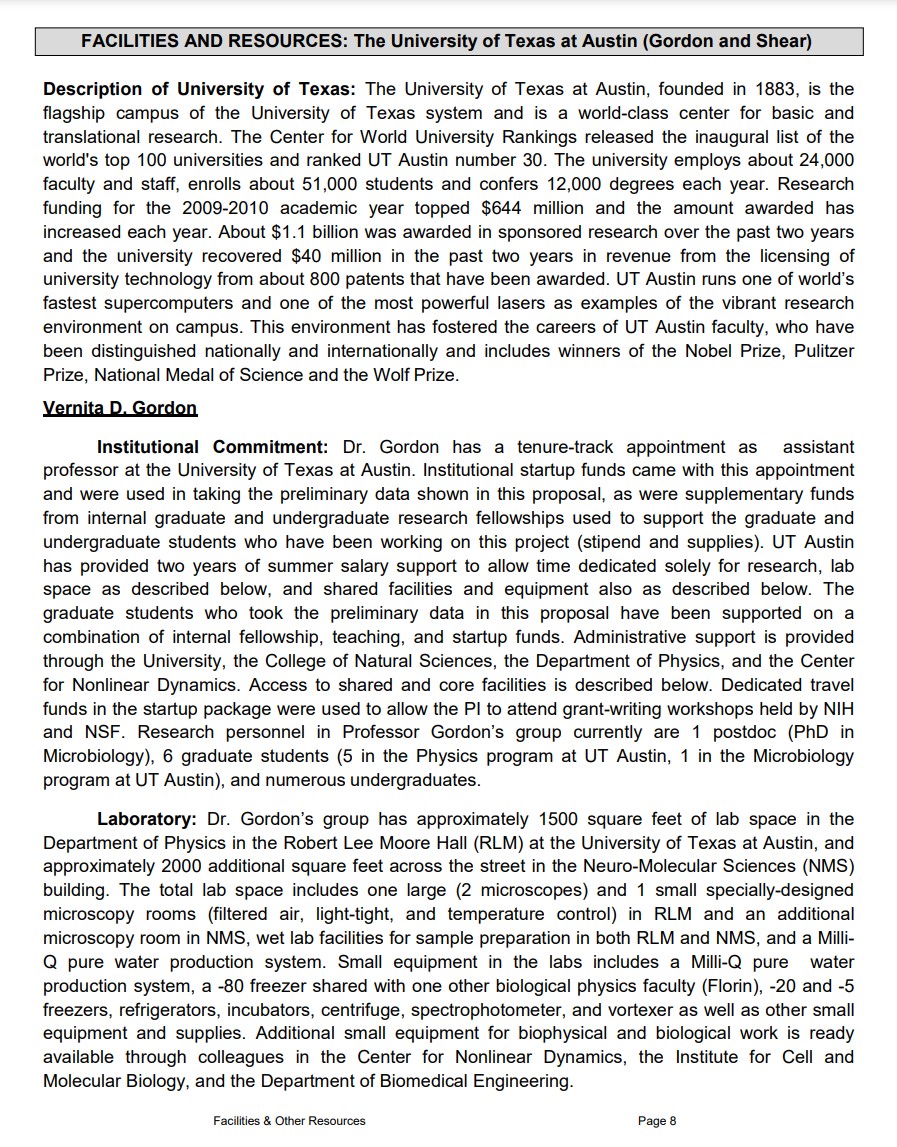If you thought you knew how ruthless research reviewers can be, you might want to think again. 21% of research papers get rejected without even a peer review. That means panelists look through a proposal, see some glaring errors, and move on to the next one. Yikes.
So how do you write a successful research proposal that won’t end up in the bin? Harvard Medical School says the best ones are clear on their objectives, describe their research methodologies, and discuss its impact on the area of study.
Sounds deceptively simple, right?
In this article, we’re going to look through 5 examples of successful research proposals. You’ll have access to free proposals that you can use as references for best practices when writing your research proposal. Let’s get started.
What is a research proposal?
A research proposal is a document outlining a planned investigation into a specific area of study. It describes the research objectives, the methodology to be employed, the resources needed, and the expected outcomes. This proposal is submitted to key stakeholders, such as academic committees or funding bodies, to secure their approval and financial support.
How long should the research proposal be?
The University of Oxford advises Masters and PhD candidates to keep it around 2,500, although there aren’t really hard limits when it comes to word counts.
If you’re in an undergraduate or graduate program, ask your mentor for your research program’s guidelines. Otherwise, visit the research organization’s website and try to look for application forms or proposal guidelines, just in case they have specificities around length.
How to write a research proposal: a step-by-step guide
Research proposals typically follow a structure. The contents may vary depending on your field or area of study.
For example, Humanities-oriented research projects might place a lot of importance on literature reviews and an explanation of the researcher’s theoretical framework; a Life Sciences proposal is more focused on detailing out the research instruments and the methodology.
In this article, we’ll go through a general approach for each section. While the advice isn’t specific to any field of study, you will see specific examples and best practices-type tips for each section that is valuable regardless of your area of study.
Let’s start with…
Prepare the title page
The title page is pretty straightforward. It usually includes:
- The title of your proposal
- Research intent (Research Proposal for Master’s Thesis)
- Name of principal research and co-investigators
- Your institution or organization
- Your supervisor’s name
- The organization or institution you’re presenting to
Your proposal’s title should be clear and self-explanatory. Aim for a title that is concise but informative, ideally between 10-15 words.
Example research proposal titles:
- Impact of Social Media on Adolescent Mental Health: A Longitudinal Study
Why it’s good: Clear, specific, and indicates both the subject (social media) and the population (adolescents).
- Optimizing Renewable Energy Systems: A Comparative Analysis of Solar and Wind Power in Urban Areas
Why it’s good: Descriptive, mentions the methodology (comparative analysis), and specifies the focus (solar and wind power in urban areas).
- The Role of Gut Microbiota in Regulating Immune Responses: Mechanisms and Implications
Why it’s good: Highlights the main topic (gut microbiota and immune responses) and hints at both mechanisms and implications.
- Evaluating the Effectiveness of Cognitive-Behavioral Therapy in Treating Anxiety Disorders: A Meta-Analysis
Why it’s good: Clear on the method (meta-analysis) and the focus (CBT and anxiety disorders).
Write the abstract
The Abstract section is a 150-200 word concise summary of your entire project. It’s written in a single paragraph, block format without any indentations.
In writing an abstract, try to answer:
- The specific problem or research question your study addresses
- The main objectives or aims of your research
- The key methods, techniques, or tools you’ll be using
- How your research will contribute to the field or address a gap in existing knowledge
How long should my abstract be?
The word counts for the Abstract differ depending on the type of research proposal. For instance:
- Academic Journals: Often require abstracts between 150 and 250 words.
- Conferences: May have specific requirements, often in the 200-300 word range.
- Thesis or Dissertation Proposals: Typically around 200-300 words, but this can vary.
- Grant Proposals: Funding agencies might have their own guidelines, usually between 150 and 300 words.
Write the introduction
The goal of the Introduction section is to provide the necessary background info and context on your proposal: why are you interested in this study? How does this study complement or disprove existing literature?
This section is where you also talk about your problem statement and research questions or objectives.
What do I include in my research proposal introduction?
- Start with an overview of the research topic: how have previous studies approached the topic?
- Mention the gaps in knowledge: what have previous studies said about the topic?
- Talk about your research objectives: how is your research going to contribute to the existing body of knowledge?
- End by talking about impact: why is it important to conduct this research?
Present your literature review
The Literature Review section shows your knowledge of the existing research–and how your study is going to contribute to it.
Another nugget of wisdom from Harvard: “Good literature reviews don’t just summarize studies, but actually evaluate them without being too dismissive.”
How do I write a good literature review?
- Mention the strengths and weaknesses of studies–this is basically the “review” part of the Literature Review section
- End the section by reiterating your research objectives
- Aim to use resources within the last 5 years. If your area of study doesn’t have a lot of research papers, it’s fine to go back to studies within the last 10 years.
- You can either review existing studies sequentially to show the development of research overtime, or discuss them thematically to present a better story
Describe your research design and methodology
Next, the Research Design and Methodology section of your research proposal answers how you’ll be doing the research.
Questions to answer in your research design:
- What’s your type of study:
Are you doing qualitative analysis? Describe how you will analyze qualitative data (e.g., thematic analysis, content analysis).
Are you doing quantitative analysis? Explain the statistical techniques you will use to analyze quantitative data (e.g., regression analysis, ANOVA).
- How are you collecting data? How will you be ensuring data integrity?
Are you conducting surveys or a population study? What demographics/populations will be included in your study? Do you have any exclusion/inclusion criteria?
Are you using specific instruments or tools? Will you be using surveys, interviews, observation checklists? How are you going to test their validity?
- Are there limitations or ethical considerations in your study?
Talk about expected outcomes and research impact
End your research proposal by reiterating the significance of research to the area of study.
You can do it by:
- Distinguishing between immediate results and longer-term implications
- Explaining how your research could influence practice, policy, or further research
- Describe practical potential applications or implications for real-world problems
Include a reference list
And you’re done! Last but not the least is the reference list.
It shows the breadth and depth of your literature review. It’s a quick reference to reviewers to show that your proposal is founded on sound research.
Different citation styles are used by different disciplines:
- APA: Education, Psychology, Sciences (e.g., biology, chemistry, physics)
- MLA: Humanities (e.g., literature, languages, philosophy)
- Chicago/Turabian: Business, History, Fine Arts (e.g., music, visual arts)
How do I format my reference list?
Citation specificities can get fussy. Thankfully, there are now citation generation tools that make it easier to create a style-compliant citation list. We like free tools like Scribbr or Citation Machine.
What are other things to include in a research proposal?
- Ethical Considerations: Add this if you’re proposing research involving human subjects, animals, or sensitive data. This section shows that you’re conscientious about data integrity and also helps reviewers feel more at ease that you’re adhering to regulatory standards.
- Timeline and Budget: Include this section if you’re looking for funding or support from an institution. Its purpose is to explain the costs involved to the stakeholders, showing them why their investment is necessary and valuable.
- Appendix: This section is relevant in complex studies requiring additional documentation, such as detailed methodologies, survey instruments, or informed consent forms
- Theoretical Framework: This makes most sense in studies aiming to contribute to theoretical knowledge or understanding within a particular field. This is commonly found in Humanities research proposals.
5 research proposal samples and templates
Research proposal with comments
This research proposal sample from the University of Houston includes reviewer comments to help you understand how to approach each section. They added comments that are applicable across disciplines, so it’s a great resource if you’re looking for a general starting point.
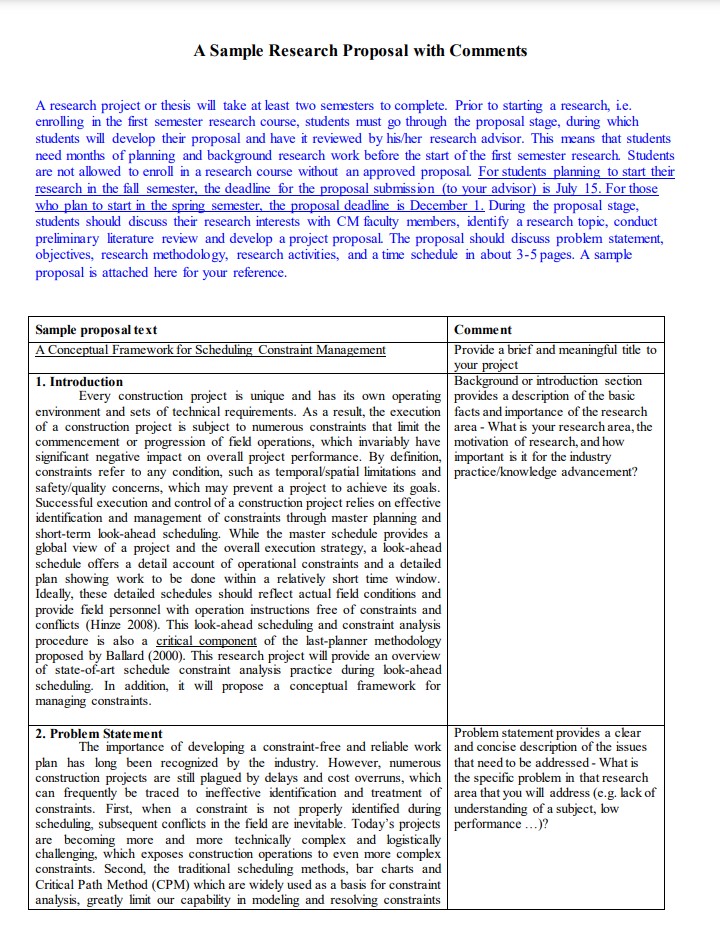
Field of study: Business, Business Management, Corporate Management
This template includes sections for:
- Introduction
- Problem statement
- Objectives
- Preliminary literature review
- Methodology
- References
Social sciences proposal sample
This research proposal sample from The Faculty of Arts and Social Sciences of The Open University includes two examples of postgraduate research proposals for sociology. One is focused on a quantitative research method, and the other one is on qualitative methodology.
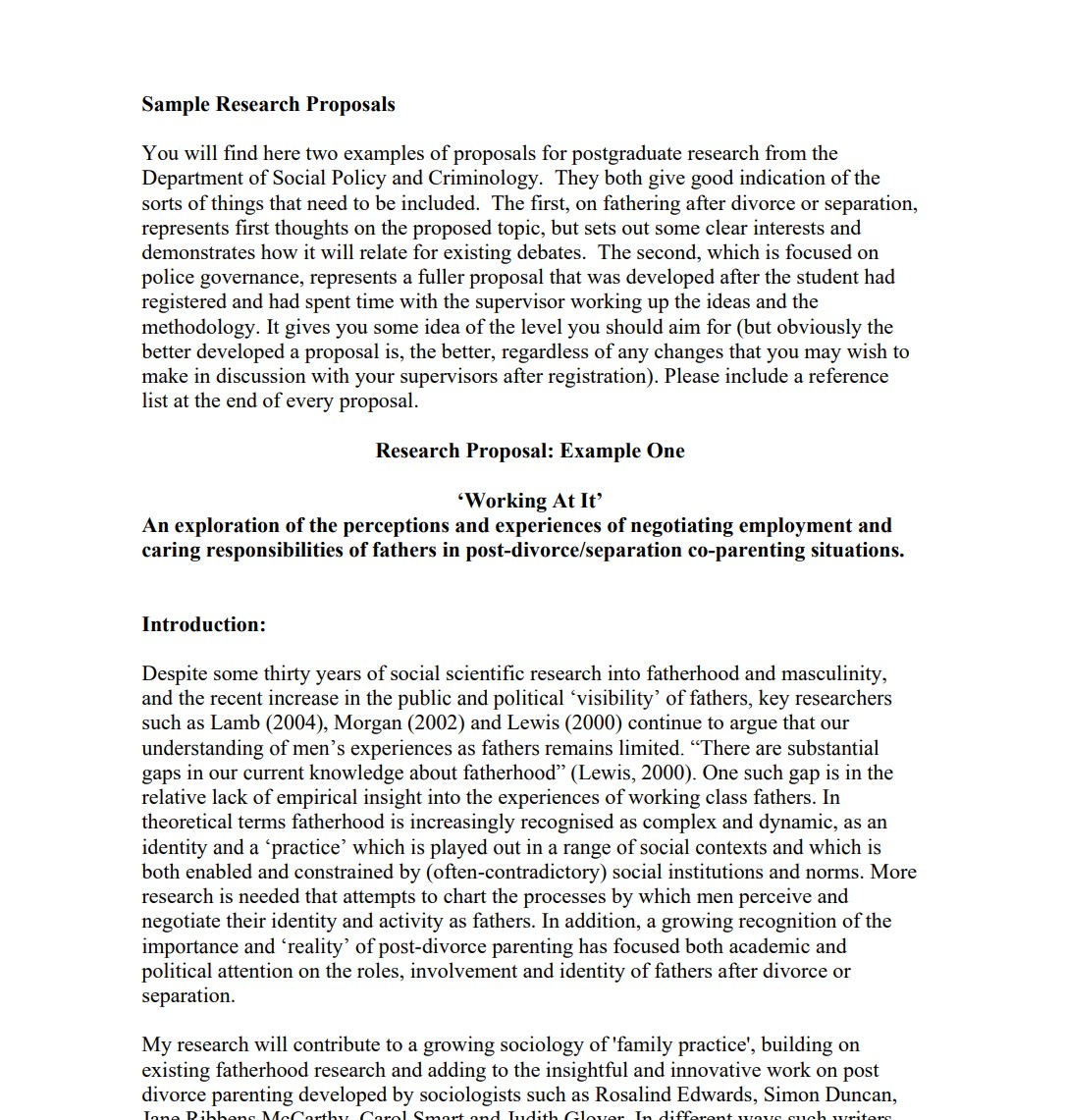
Field of study: Sociology, Social Policy, Criminology
This template includes sections for:
- Introduction
- Research questions
- Data collection
- Data analysis
- Theoretical contribution
- Research timetable
Editable research proposal template
This comprehensive proposal template from PandaDoc is editable and includes all the essential elements to a research proposal. There’s a timetable at the end if your proposal requires a research timeline.
You can customize this template and use it as a starting point when drafting your own research proposal. All the sections are laid out – the most you’d have to do is edit in your actual information.
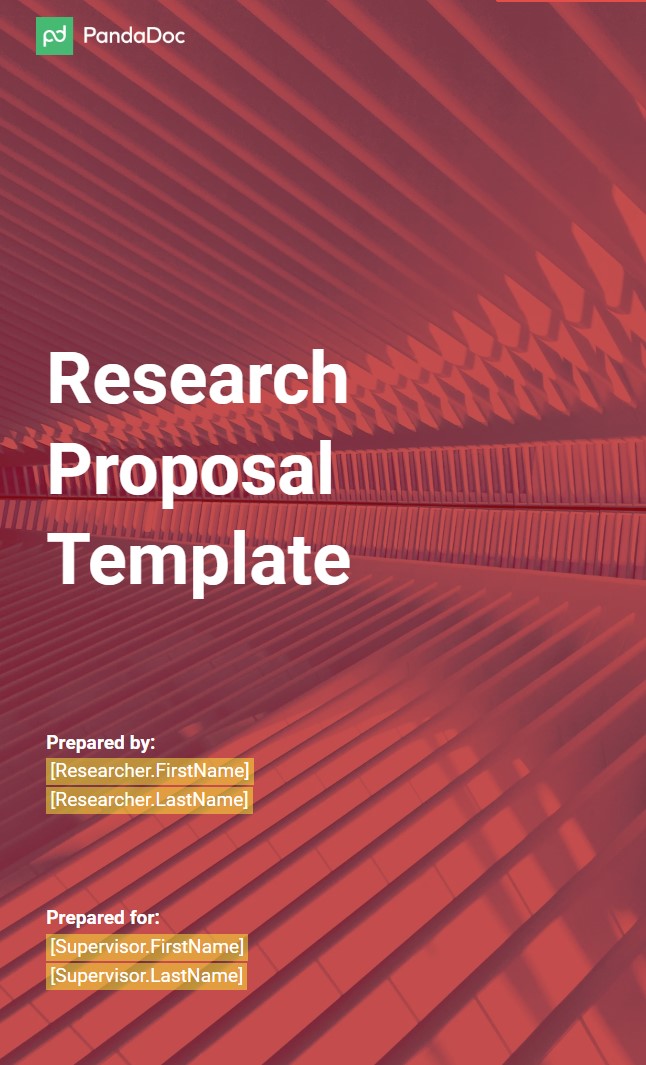
Field of study: Applicable to any
This template includes sections for:
- Title
- Abstract
- Table of contents
- Introduction
- Problem statement
- Objectives
- Literature review
- Notion of original research
- Key assertions and objectives
- Research methods
- Sample audience
- Research questions
- Research design
- Analysis
- Research timetable
Life sciences proposal sample
This is an example of an accepted life science proposal to the National Institute of Allergy and Infectious Diseases. It’s a perfect reference if you’re pitching your research proposal to a funding body or government organization.
Field of study: Biology, Life sciences
This template includes sections for:
- Research plan
- Facilities and research instruments
- Ethical considerations for animal testing
- Introduction
- Aims and objectives
- Research strategy
- Justification and feasibility
- Research design
Engineering and technology proposal sample
This is an example of an accepted engineering research proposal to the Mellon Foundation. While it’s technically a grant proposal, it’s still a great example of how to reiterate the importance of a research project.
This proposal is can also show you how to contextualize your research objectives within the field of study or the community it is most impacted by.
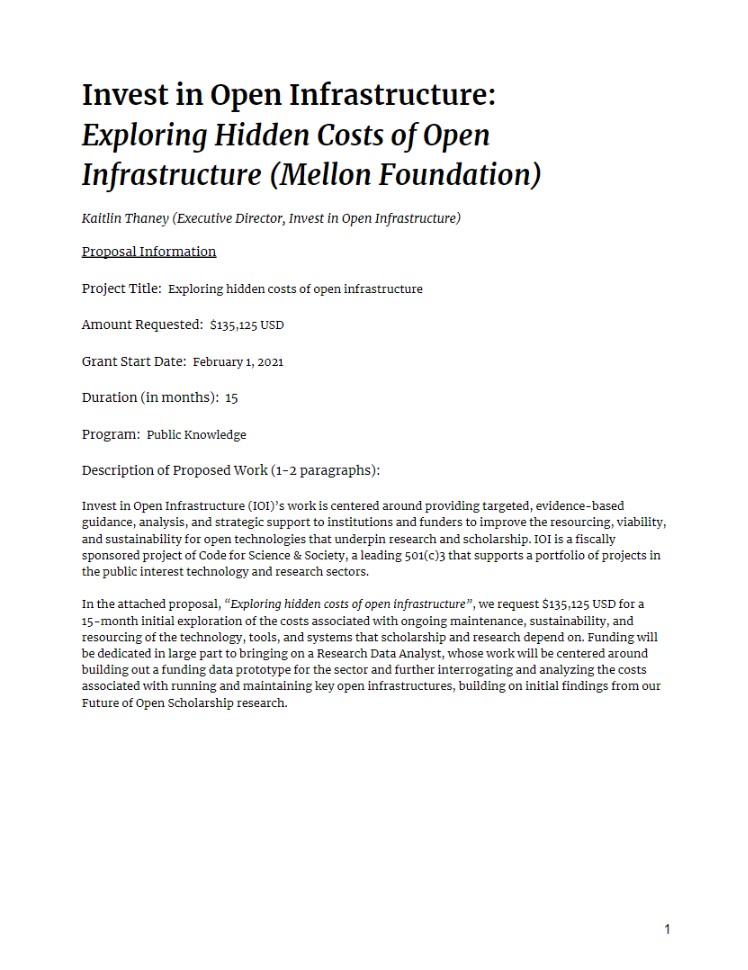
Field of study: Information technology, Data engineering, Computer science
This template includes sections for:
- Proposal activities and rationale
- Previous and related work
- What needs to be done
- What we need to accomplish these tasks
- Means by which we’ll make the findings available to the community
- Description of the researchers
- Technology used
- Expected outcomes
- Long-term sustainability of project results
What makes a research proposal fail?
We know that proposals definitely get rejected.
As intimidating as that sounds, the great news is that we know why they’re getting rejected in the first place. According to a study involving 20 research proposals from Master’s degree students, there are usually seven key themes that rejected research proposals fall under.
The researchers reviewed these proposals from the students, and itemized the reasoning behind their rejection.
In other words, here are the pitfalls you want to avoid:
Lack of logical continuity
What the reviewers had to say
- “The background section doesn’t connect to the problem statement.”
- “The problem statement doesn’t match the title.”
- “There’s repetitive information across various sections.”
Superficial
What the reviewers had to say
- “The study’s purpose and how it will be conducted aren’t clearly explained. (e.g., ‘A plan will be designed to analyze the data.’)”
- “Many claims in the proposal aren’t backed up with solid evidence.”
- “The literature review is too focused on one area and misses other important details and past research.”
- “Key details like what’s being studied, how many people are involved, and why certain samples and methods were chosen are not provided.”
Lack of proper justification
What the reviewers had to say
- “The justification for using an exploratory design is inappropriate or not provided.”
- “The rationale for choosing specific research instruments is flawed. (E.g., ‘I won’t be doing this because it’s costly.’)”
Subjective content
What the reviewers had to say
- “It assumes certain outcomes, like stating ‘the training is insufficient’ without investigating the actual quality of the training. It suggests that workers possess technical skills but lack communication skills necessary for dialogue-oriented advisory work, without first verifying this claim.”
- “The selection of subjects may be biased, chosen because the candidate is already familiar with the population.”
- “The rationale for the study is based improperly on the researcher’s personal observations rather than on solid, empirical evidence.”
Confusion about the elements of the proposal
What the reviewers had to say
- “The introduction resembles a literature review rather than setting the stage for the study.”
- “No problem statement is provided.”
- “Lack of explanation on which aspects of the study will use qualitative methods, and why.”
- “Previous research findings are missing from the literature review.”
- “Literature review includes topics not pertinent to the actual subject matter of the study.”
- “Definitions of key concepts are not referenced properly, and ‘common’ definitions are used instead.”
- “Ethical considerations are listed but don’t explain how they’ll be applied.”
No foundational methodological knowledge
What the reviewers had to say
- “Researcher mentions random sampling but all says that all employees will be selected.”
- “Does not specify the observation instruments.”
- “Uses a large sample size but mentions that both quantitative and qualitative design types will be used.”
Technical mistakes
What the reviewers had to say:
- “References not listed alphabetically.”
- “Too many loose paragraphs.”
- “Use of unscientific language (e.g., ‘The purpose of interviewing is to find out what is in or on someone else’s mind.’)”
- “Grammatical and punctuation errors are present.”
The ultimate research proposal checklist
The central theme around rejection is really about a lack of detail. As long as you follow the organization’s guidelines, use clear and concise language to explain each section, and review your proposal for glaring mistakes, you can be sure that you won’t be part of that 21%.
Still overwhelmed? Here’s a quick checklist summarizing the key takeaways from this article:
- Did you clearly state what you want to achieve with your research?
- Did you provide a clear problem statement?
- Did you provide a comprehensive, unbiased literature review?
- Did you clearly explain your research design and methodology?
- Did you mention all the resources you need to carry out the research?
- Did you describe the phases or general timeline of your research project?
- Did you discuss why your research is important and what it adds to the field?
- Did you include references to support your claims and methodology?
- Did you check your proposal for clarity, grammar, and accuracy before submitting?


